 But some of the mountain passes we saw in southern Spain were as beautiful, or more so, than anything I've seen here in the USA - comparable to Yosemite.
But some of the mountain passes we saw in southern Spain were as beautiful, or more so, than anything I've seen here in the USA - comparable to Yosemite. Yes, we are lucky to have areas of such natural beauty (maybe luckiest) but it's because of our huge national park system and and public lands, and because we are just barely coming out of the pioneer stage that it seems unique. There's still so much unsettled land out there, we don't have centuries of civilization leaving grasslands where there were once trees, and forests planted in rows where there was once natural forest, leaving marks everywhere (which is beautiful in a different way). Our 'old' history is the native american, the aztecs and incas, and they didn't leave much of a mark! just a few crumbling remnants (e.g. Machu Picdhu :) and pueblos ... and scattered piles of obsidian flints, and drawings on cave walls, and doodles on boulders.
There's a stretch of trail along the Snake River which I love. The Snake River is a major river in the northwest USA, fed into by various mountain sources, and eventually emptying into the Columbia River, and into the Pacific Ocean.
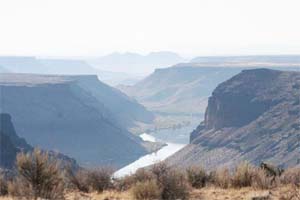 The Snake's origin is in Wyoming in the Yellowstone Park region, flowing into and out of Jackson lake. It gathers in volume as it flows westward across the southern Idaho plains. This river has carved immense canyons in it's downhill journey, primarily due to episodic flooding of glacial formed lakes (Lake Bonneville, Lake Idaho) during the ice ages.
The Snake's origin is in Wyoming in the Yellowstone Park region, flowing into and out of Jackson lake. It gathers in volume as it flows westward across the southern Idaho plains. This river has carved immense canyons in it's downhill journey, primarily due to episodic flooding of glacial formed lakes (Lake Bonneville, Lake Idaho) during the ice ages. For as long as 11,000 years ago Native American people lived along the Snake River. There is a very special section of the river which is littered with huge rounded boulders, sometimes called 'Murphy Melons' by the locals.
 These boulders, often as big as houses, were formed as huge chunks of basalt broke away from the walls of the river canyon as it was growing deeper and experiencing massive flooding episodes. These chunks of basalt were rolled down the river, farther with each flood, becoming rounder as the edges were broken off, and finally coming to rest along the river bank as the ice age retreated. The boulders formed a patina - from the tumbling and the weathering, and were the perfect palette for the drawings of the people that lived along the river so long ago.
These boulders, often as big as houses, were formed as huge chunks of basalt broke away from the walls of the river canyon as it was growing deeper and experiencing massive flooding episodes. These chunks of basalt were rolled down the river, farther with each flood, becoming rounder as the edges were broken off, and finally coming to rest along the river bank as the ice age retreated. The boulders formed a patina - from the tumbling and the weathering, and were the perfect palette for the drawings of the people that lived along the river so long ago. I've taken several rides along this trail - 'The Petroglyphs' - having been shown the area by locals soon after we moved here. It is very special, and still available to anybody that can walk, bike or ride down to it.
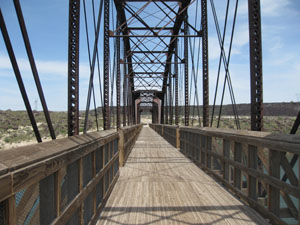 Years ago Carol and I hiked another section of the Snake River Canyon - downstream from the Petroglyphs trail, and upstream from Guffy Bridge - an old railroad bridge that was built across the river to transport gold and silver ore from the mines at Silver City to Boise, where it would be processed and sold. The old rail bridge was converted to a public 'foot' bridge by the Idaho Historical Society, and now connects Celebration Park on the north side of the river, to Owyhee County on the south - with a quietly used and maintained trail system.
Years ago Carol and I hiked another section of the Snake River Canyon - downstream from the Petroglyphs trail, and upstream from Guffy Bridge - an old railroad bridge that was built across the river to transport gold and silver ore from the mines at Silver City to Boise, where it would be processed and sold. The old rail bridge was converted to a public 'foot' bridge by the Idaho Historical Society, and now connects Celebration Park on the north side of the river, to Owyhee County on the south - with a quietly used and maintained trail system. 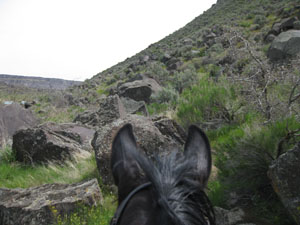 We were scouting for 'really big loop' ride possibilities - what if we could ride up one side of the river, and down the other? The options were to cross at Swan Falls dam (too narrow and scary, that wouldn't work) or at Guffy Bridge - a great crossing. But, there were these unpassable boulders, those huge chunks of basalt that tumbled down from the canyon walls. As we hiked the connection between Guffy Bridge and the Petroglyphs trail we thought - nope, not for horses. (unless our friend Charlie wants to come over with some dynamite).
We were scouting for 'really big loop' ride possibilities - what if we could ride up one side of the river, and down the other? The options were to cross at Swan Falls dam (too narrow and scary, that wouldn't work) or at Guffy Bridge - a great crossing. But, there were these unpassable boulders, those huge chunks of basalt that tumbled down from the canyon walls. As we hiked the connection between Guffy Bridge and the Petroglyphs trail we thought - nope, not for horses. (unless our friend Charlie wants to come over with some dynamite). But - leave it to Tom Noll and Frank (the horse) and Whiskey (the adopted Owyhee mustang - who went home with Tom after a ride in the Owyhees as an orphaned colt in the back seat of his van) (or so the story goes...) - leave it to them to try that unride-able trail and deem it ride-able. The Whiskey Traverse. Or so they say....
 So, not wanting to subject my riders to a trail that would cause undo fear or harm, we set out to test it ourselves. Merri/Jose and Carol/Sooz and me/Batman (new superhero horse) - hauled over to the river and rode up that unride-able trail, and then back down that unride-able trail, and sure enough - it can be done. Let the horse pick it's way through the boulders, they make it seem so easy, stay out of their way and just stay balance. no problem!
So, not wanting to subject my riders to a trail that would cause undo fear or harm, we set out to test it ourselves. Merri/Jose and Carol/Sooz and me/Batman (new superhero horse) - hauled over to the river and rode up that unride-able trail, and then back down that unride-able trail, and sure enough - it can be done. Let the horse pick it's way through the boulders, they make it seem so easy, stay out of their way and just stay balance. no problem! So now we CAN ride down one side of the river, and back up the other. Of course there's still the issue of being a long long way from base camp - and until I come up with a point-to-point ride we're still bound by home range distance - so it will be an 'up the river, and over the bridge to the other side' ride. It's a start!
So now we CAN ride down one side of the river, and back up the other. Of course there's still the issue of being a long long way from base camp - and until I come up with a point-to-point ride we're still bound by home range distance - so it will be an 'up the river, and over the bridge to the other side' ride. It's a start! And of course after our long and dangerous ride we had to stop in Murphy on the way home, for a famous Murphy Burger. Another mission accomplished!
And of course after our long and dangerous ride we had to stop in Murphy on the way home, for a famous Murphy Burger. Another mission accomplished!more photos from our ride at http://www.endurance.net/International/USA/2010Fandango/gallery/WhiskeyTraverse/index.htm
Steph
p.s. Fernando, are you reading this? if so, Hola to you and Paco and the whole Maximoto team from Steph and Maxi!
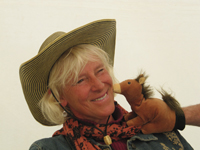
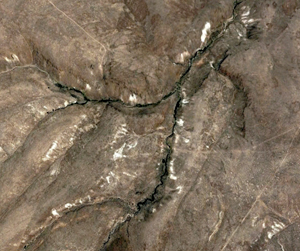 But yesterday I had a real mission, simple and well defined: find a piece of trail across Browns Creek (actually a point where two drainages come together and empty into the real Browns Creek which comes down off the mountians. I needed to find another way to get up to Toy Mountain, and the section of beautiful trail and granitic boulders above Alder Creek. The road we usually use is so nasty rocky, and this alternate would be much nicer.
But yesterday I had a real mission, simple and well defined: find a piece of trail across Browns Creek (actually a point where two drainages come together and empty into the real Browns Creek which comes down off the mountians. I needed to find another way to get up to Toy Mountain, and the section of beautiful trail and granitic boulders above Alder Creek. The road we usually use is so nasty rocky, and this alternate would be much nicer.  Merri and I loaded Jose and Jaziret (Rhet) in our small trailer, printed out a picture off Google Earth of the terrain in case we needed a reference, and headed south. Perfect day, full spring here in the Owyhee front, fresh smelling desert from a recent rain, sun, ahh... And the cattle have just been turned out on the upper pastures, lots of mama's and baby's, looking pretty happy with all the grass.
Merri and I loaded Jose and Jaziret (Rhet) in our small trailer, printed out a picture off Google Earth of the terrain in case we needed a reference, and headed south. Perfect day, full spring here in the Owyhee front, fresh smelling desert from a recent rain, sun, ahh... And the cattle have just been turned out on the upper pastures, lots of mama's and baby's, looking pretty happy with all the grass.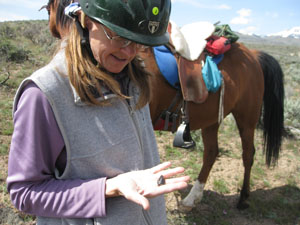 It actually turned out to be ridiculously easy to find a way through. We fiddled around going out, looking for options, climbing up over the bluff and looking down into the creek, then meandered along another drainage. We were on a nice open hill where we could see down into the drainage, and also see the mountains to the north and west and south, Merri said - hmm... lots of obsidian. Lots of shavings! and when we started looking closer we found bits and pieces of arrow heads. It must have been a preferred location for obsidian knapping. Very cool.
It actually turned out to be ridiculously easy to find a way through. We fiddled around going out, looking for options, climbing up over the bluff and looking down into the creek, then meandered along another drainage. We were on a nice open hill where we could see down into the drainage, and also see the mountains to the north and west and south, Merri said - hmm... lots of obsidian. Lots of shavings! and when we started looking closer we found bits and pieces of arrow heads. It must have been a preferred location for obsidian knapping. Very cool. 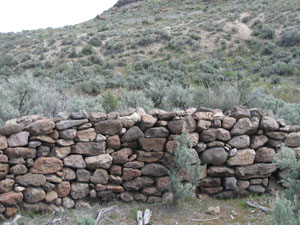 We rode on down the hillside, to the flat where the two drainages came together. Merri noticed a big nest, and two red tailed hawks flush out of the tree as we approached. They both settled on the point of a big rock above and watched us.
We rode on down the hillside, to the flat where the two drainages came together. Merri noticed a big nest, and two red tailed hawks flush out of the tree as we approached. They both settled on the point of a big rock above and watched us.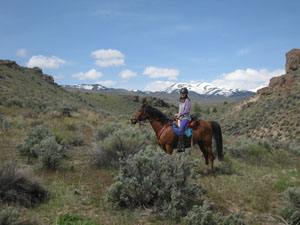 We then found a trail, and followed it wondering where it would go. It did exactly the right thing and a mile later we were at the road that I wanted to find. We picked out the granite bluff hills which would be part of the trail, surveyed all around getting oriented so that we could find it again from the other direction. An easy ride back following the trail, and then we cut up through the creek instead of on the bluffs above.
We then found a trail, and followed it wondering where it would go. It did exactly the right thing and a mile later we were at the road that I wanted to find. We picked out the granite bluff hills which would be part of the trail, surveyed all around getting oriented so that we could find it again from the other direction. An easy ride back following the trail, and then we cut up through the creek instead of on the bluffs above.  Another trail (thank you mama cows) and a little bit of brush and creek crossing, and right back where we started. Perfect. A new little section of trail through a very pretty little drainage. Fandango day 1, it's all set now.
Another trail (thank you mama cows) and a little bit of brush and creek crossing, and right back where we started. Perfect. A new little section of trail through a very pretty little drainage. Fandango day 1, it's all set now. 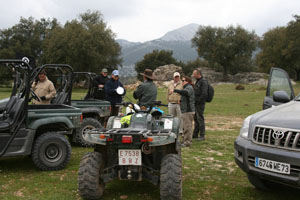 I also put up a little gallery of the people 'behind the scenes' : for every horse and rider there are a dozen people working for and around them. Setting things up, taking them down. Arranging meals, transport, paperwork, trail marking, trail un-marking, trail finding, camp finding. New trail, old trail. New towns, new city councils to smooze. New vehicles, repairing old vehicles. Phones, computers, printers, cameras, etc etc. All so we can have fun and ride!
I also put up a little gallery of the people 'behind the scenes' : for every horse and rider there are a dozen people working for and around them. Setting things up, taking them down. Arranging meals, transport, paperwork, trail marking, trail un-marking, trail finding, camp finding. New trail, old trail. New towns, new city councils to smooze. New vehicles, repairing old vehicles. Phones, computers, printers, cameras, etc etc. All so we can have fun and ride!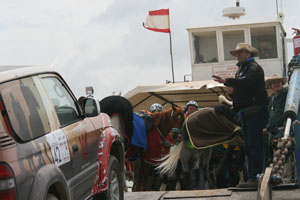 A totally amazing event... it's going to take a while to come down from this one. So intense and consuming for so long. The people become family, helping each other out. Laughing together, sharing the highs and lows, sharing the trail. Drinking and dancing together. The horses learn to put up with everything and anything and eat when they can, and drink when they can, and rest when they can.
A totally amazing event... it's going to take a while to come down from this one. So intense and consuming for so long. The people become family, helping each other out. Laughing together, sharing the highs and lows, sharing the trail. Drinking and dancing together. The horses learn to put up with everything and anything and eat when they can, and drink when they can, and rest when they can.  The Vandals moved briefly through the region during the 5th century AD before settling in North Africa. The Muslim conquest of the Iberian Peninsula (including Andalusia) in 711–718 marked the collapse of Visigothic rule and the establishment of the Islamic Empire era. Then came the Christian conquest: Córdoba was conquered in 1236 and Seville in 1248. The fall of Granada in 1492 put an end to Muslim rule in the Iberian peninsula. ...that's a lot of different people and cultures, each having their own effect on the culture, the architecture, the food, the agriculture.
The Vandals moved briefly through the region during the 5th century AD before settling in North Africa. The Muslim conquest of the Iberian Peninsula (including Andalusia) in 711–718 marked the collapse of Visigothic rule and the establishment of the Islamic Empire era. Then came the Christian conquest: Córdoba was conquered in 1236 and Seville in 1248. The fall of Granada in 1492 put an end to Muslim rule in the Iberian peninsula. ...that's a lot of different people and cultures, each having their own effect on the culture, the architecture, the food, the agriculture. 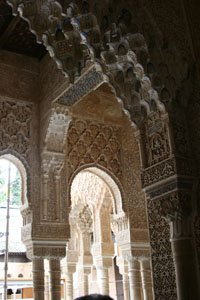 Every city we went through had crumbling or well maintained remnants of a people that lived here a very very long time ago. On our day off in Grenada I had a chance to visit La Alhambra - a palace and fortress complex constructed during the early 14th century by the Moorish rulers of the Emirate of Granada in Al-Andalus. Spectacular!! and so old...
Every city we went through had crumbling or well maintained remnants of a people that lived here a very very long time ago. On our day off in Grenada I had a chance to visit La Alhambra - a palace and fortress complex constructed during the early 14th century by the Moorish rulers of the Emirate of Granada in Al-Andalus. Spectacular!! and so old...
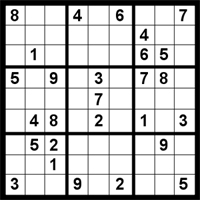 I was really lucky to get a flight out when I did, my scheduled flight was one of the first authorized to leave Barcelona in a few days. (Iceland's volcano!) So I had it pretty good, but it was very chaotic in all the airports. Many tired passengers, all the flights were bursting at the seam, security lines and check in lines were impossibly slow.
I was really lucky to get a flight out when I did, my scheduled flight was one of the first authorized to leave Barcelona in a few days. (Iceland's volcano!) So I had it pretty good, but it was very chaotic in all the airports. Many tired passengers, all the flights were bursting at the seam, security lines and check in lines were impossibly slow. 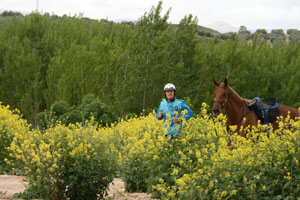 So now I'm home at last, and it is very very green and raining! I guess I'm the El Nino girl this year - following the extreme weather patterns around the world... Arizona and Andalucia have both had record winter and spring rains. And our little corner of Idaho desert is wetter and greener than I've ever seen it. But wow, I had the chance to experience TWO spring's - watching the Sonoran desert burst into incredible bloom, and also Andalucia - wildflowers galore. I haven't seen Oreana in the daylight yet (couldn't sleep more than a few hours last night - I think I've forgotten how to sleep a regular night's sleep - and I was dreaming in Spanish!). But I could see a lot of tall grass and flowers along the road and driveway - so now I'll get one more Springtime!
So now I'm home at last, and it is very very green and raining! I guess I'm the El Nino girl this year - following the extreme weather patterns around the world... Arizona and Andalucia have both had record winter and spring rains. And our little corner of Idaho desert is wetter and greener than I've ever seen it. But wow, I had the chance to experience TWO spring's - watching the Sonoran desert burst into incredible bloom, and also Andalucia - wildflowers galore. I haven't seen Oreana in the daylight yet (couldn't sleep more than a few hours last night - I think I've forgotten how to sleep a regular night's sleep - and I was dreaming in Spanish!). But I could see a lot of tall grass and flowers along the road and driveway - so now I'll get one more Springtime! Now, with a cup of coffee, I'm sitting at the desk with Sam the Siam cat, enjoying the plants and blossoms from last years garden on the table near the desk (I bring them in before it freezes and Merri kept them faithfully watered all winter). Ready to summarize the Raid Kaliber Andalucia extravaganza. It is really an amazing event but on by extraordinary people. They know how to make things happen - are masters and improvization when things go astray - always always laughing and smiling and causing others to do the same. Spanish time... and my god these people know how to have fun.
Now, with a cup of coffee, I'm sitting at the desk with Sam the Siam cat, enjoying the plants and blossoms from last years garden on the table near the desk (I bring them in before it freezes and Merri kept them faithfully watered all winter). Ready to summarize the Raid Kaliber Andalucia extravaganza. It is really an amazing event but on by extraordinary people. They know how to make things happen - are masters and improvization when things go astray - always always laughing and smiling and causing others to do the same. Spanish time... and my god these people know how to have fun. 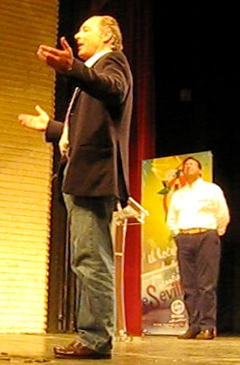 The last night in Cazorla we had awards at the Juntamiento (city hall) with much fanfare, capped by Jose Manuel Soto singing the anthem of Andalucia. Then a big dinner, then dancing the night away! Dancing and singing (Soto would grab the microphone every once in a while and sing along with the DJ's picks). When he wasn't singing he was dancing with everybody else. Lots of free-form dance technique (YMCA, Gloria, I Will Survive...), lots of Spanish-Andalucian music which transformed some of the riders and staff into expressive Flamenco dancers - some of them were really good! It was so much fun, I finally dragged myself off to bed at 3:30am.
The last night in Cazorla we had awards at the Juntamiento (city hall) with much fanfare, capped by Jose Manuel Soto singing the anthem of Andalucia. Then a big dinner, then dancing the night away! Dancing and singing (Soto would grab the microphone every once in a while and sing along with the DJ's picks). When he wasn't singing he was dancing with everybody else. Lots of free-form dance technique (YMCA, Gloria, I Will Survive...), lots of Spanish-Andalucian music which transformed some of the riders and staff into expressive Flamenco dancers - some of them were really good! It was so much fun, I finally dragged myself off to bed at 3:30am.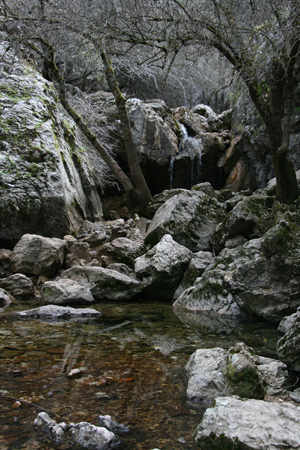 Five hundred kilometers of trail in eight days of riding. From Sevilla the heart of Andalucia, to the Atlantic Ocean where the Rio Guadalquiver finds its destination - where the city of Sanlucar de Barrameda was built to guard this important port. Through farmlands with olive trees, cottonwood forests, herds of sheep and goats that roam the rocky hills which are too steep for anything else ... to Grenada where the Moors built one of their last cities of retreat as they fled this land - to Cazorla - to the source, the nacimiento of the Guadalquivir - a tiny pool of water that gathers strength as it falls out of the mountains, the river that is the life blood of Andalucia.
Five hundred kilometers of trail in eight days of riding. From Sevilla the heart of Andalucia, to the Atlantic Ocean where the Rio Guadalquiver finds its destination - where the city of Sanlucar de Barrameda was built to guard this important port. Through farmlands with olive trees, cottonwood forests, herds of sheep and goats that roam the rocky hills which are too steep for anything else ... to Grenada where the Moors built one of their last cities of retreat as they fled this land - to Cazorla - to the source, the nacimiento of the Guadalquivir - a tiny pool of water that gathers strength as it falls out of the mountains, the river that is the life blood of Andalucia.  This is Endurance - this is magnificent. The course is not easy. There are sandy stretches along the Atlantic coast, trails through marshland, through Donana National Park - the most important National Park in Europe both in size and in diversity of flora and fauna. Through farmland and villages, over mountain passes with steep rocky trails and long climbs. Long days, and easy days - and combined over eight days together it is true challenge for horse and rider.
This is Endurance - this is magnificent. The course is not easy. There are sandy stretches along the Atlantic coast, trails through marshland, through Donana National Park - the most important National Park in Europe both in size and in diversity of flora and fauna. Through farmland and villages, over mountain passes with steep rocky trails and long climbs. Long days, and easy days - and combined over eight days together it is true challenge for horse and rider.  And it is also a ride through history - centuries of civilization still stand as forts and castles and Roman era bridges, Arab palaces, Castilian cathedrals, stone and mud walls and houses crumbling with age or maintained through the generations. People of mixed ancestry, people that enjoy life like none other. Spanish time... different from the rest of the world. The laughter and chatter and good food, wine. I'm sure what we're experiencing through this even is a little beyond the 'real world' - but that is part of what makes it such an amazing and consuming experience. Day after day the focus is the motion - horses crossing the land, support rigs making it possible, organizers making it happen. From late nights of meetings and dining and taking care of the horse - to early morning starts at some new unlikely location. The same horses, the same people, different land.
And it is also a ride through history - centuries of civilization still stand as forts and castles and Roman era bridges, Arab palaces, Castilian cathedrals, stone and mud walls and houses crumbling with age or maintained through the generations. People of mixed ancestry, people that enjoy life like none other. Spanish time... different from the rest of the world. The laughter and chatter and good food, wine. I'm sure what we're experiencing through this even is a little beyond the 'real world' - but that is part of what makes it such an amazing and consuming experience. Day after day the focus is the motion - horses crossing the land, support rigs making it possible, organizers making it happen. From late nights of meetings and dining and taking care of the horse - to early morning starts at some new unlikely location. The same horses, the same people, different land. Jose Manuel Soto and his team have created a true Endurance Ride.
Jose Manuel Soto and his team have created a true Endurance Ride. With a seven day overall time of 26:54:50 the #3 team of Paulette Maldera (riding Louna Rivoiron) and Daniel Maldera (riding Otello de Rivoiron) are in first place.
With a seven day overall time of 26:54:50 the #3 team of Paulette Maldera (riding Louna Rivoiron) and Daniel Maldera (riding Otello de Rivoiron) are in first place. 
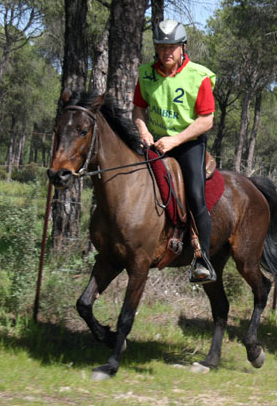 Three minutes behind at 26:50:10 are the #2 team of Pierre Chambost riding Mourad del Sol and Jean Pierre Lerisset on Massar.
Three minutes behind at 26:50:10 are the #2 team of Pierre Chambost riding Mourad del Sol and Jean Pierre Lerisset on Massar. 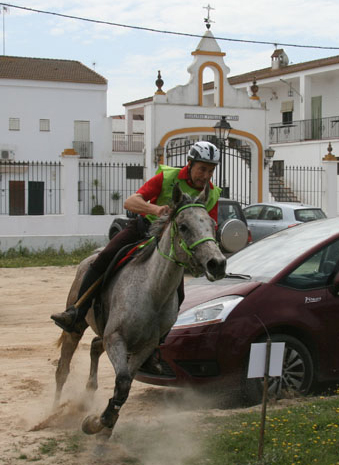
 Veronique Gaillard (riding Loukom) and Yvan Gaillard (riding Nasir de la Loze)
Veronique Gaillard (riding Loukom) and Yvan Gaillard (riding Nasir de la Loze) are 7 minutes behind the leaders.
are 7 minutes behind the leaders.  The next closest team is Jose Antonion Aguilar Viana riding Rayito and Baney with an overall time of 27:44:10.
The next closest team is Jose Antonion Aguilar Viana riding Rayito and Baney with an overall time of 27:44:10. 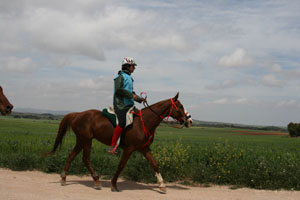 Eduardo Sanchez and Hidalgo Hermes with an overall time of 31:26:16.
Eduardo Sanchez and Hidalgo Hermes with an overall time of 31:26:16.  Germany's Heike Blumel on Lens Armstrong and Swiss rider
Germany's Heike Blumel on Lens Armstrong and Swiss rider 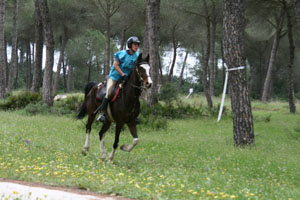 Elsbeth Brunner on Capoe.
Elsbeth Brunner on Capoe. 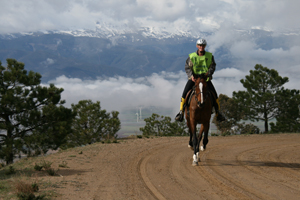 I'm finally warm and dry. Still listening to the rain fall outside. There was a news flash on the TV this afternoon about the heavy rains and flooding.
I'm finally warm and dry. Still listening to the rain fall outside. There was a news flash on the TV this afternoon about the heavy rains and flooding. 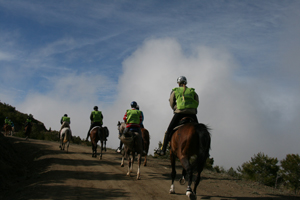 The sun was breaking through the clouds as the riders headed up into the hills - and in and outof the fog. The trail was entirely through a national park - high mountain pass of 9000 ft, still snow in places.
The sun was breaking through the clouds as the riders headed up into the hills - and in and outof the fog. The trail was entirely through a national park - high mountain pass of 9000 ft, still snow in places.  The hail was stinging the eyes making it hard to see. Antonio was driving with his face covered as much as possible. We got totally drenched, there were little snow drifts on our clothes, and the water pooled into the seats soaking our pants. Antonio's hands were clenched on the steering wheel and I could see the water streaming from his gloves. Every once in a while I could hear a grunt from the camera guys who were standing in the back of the Rhino - well actually they were hunkering down as best they could. Nothing like being in the driving rain and hail while going down the road at 30mph with no cover! I was scrunched down as best I could, but there's not a whole lot of option there...
The hail was stinging the eyes making it hard to see. Antonio was driving with his face covered as much as possible. We got totally drenched, there were little snow drifts on our clothes, and the water pooled into the seats soaking our pants. Antonio's hands were clenched on the steering wheel and I could see the water streaming from his gloves. Every once in a while I could hear a grunt from the camera guys who were standing in the back of the Rhino - well actually they were hunkering down as best they could. Nothing like being in the driving rain and hail while going down the road at 30mph with no cover! I was scrunched down as best I could, but there's not a whole lot of option there...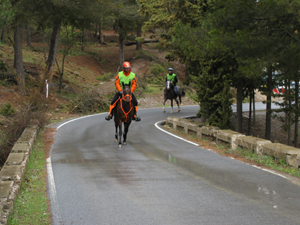 But - the horses did fantastic today! They all had a day of rest yesterday, and the looked really good, and fresh, this morning. Riders were happy. Cool wet weather isn't quite so bad for riding, and I think it was actually perfect for the horses as they could move along quite quickly. The riders didn't seem too miserable. The vets and timers and all were looking pretty wet and cold though.
But - the horses did fantastic today! They all had a day of rest yesterday, and the looked really good, and fresh, this morning. Riders were happy. Cool wet weather isn't quite so bad for riding, and I think it was actually perfect for the horses as they could move along quite quickly. The riders didn't seem too miserable. The vets and timers and all were looking pretty wet and cold though.  We stayed with a few of the front runners, but then it started raining again, so hard that it was impossible to take the cameras out. We followed an amazing old narrow road down to the finish, and just before we got there Paula spotted a cafe -'stop!' - and in we go for a cup of coffee while Xavier went on to the finish. The coffee so good, and so warm to hold in the hands that we each had two :)
We stayed with a few of the front runners, but then it started raining again, so hard that it was impossible to take the cameras out. We followed an amazing old narrow road down to the finish, and just before we got there Paula spotted a cafe -'stop!' - and in we go for a cup of coffee while Xavier went on to the finish. The coffee so good, and so warm to hold in the hands that we each had two :)  Ok - there's no way I'm going to be able to keep up! I'm going to have to wait until this is over for the real story. I'm not sure who is still in the race, and how the times and results are going - there is so much to tell, but it's going to have to come later. I'll keep posting bits here and there for now.
Ok - there's no way I'm going to be able to keep up! I'm going to have to wait until this is over for the real story. I'm not sure who is still in the race, and how the times and results are going - there is so much to tell, but it's going to have to come later. I'll keep posting bits here and there for now.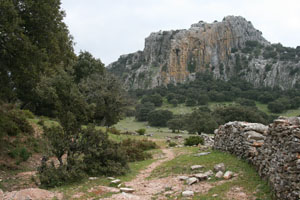 Tired riders and horses - it was a VERY challenging course today - mountains, hard roads, steep trails.
Tired riders and horses - it was a VERY challenging course today - mountains, hard roads, steep trails. 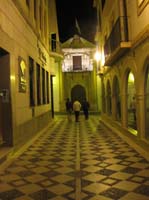 Now as I write, it's the following evening.. but I'll have to add to yesterday's summary, that the evening's reception, ride meeting and awards were held at the museum in Ronda - the Mondragon's Palace, known also as Palace of the Marquis of Villasierra - built in the 13th century, when Andalucia was still governed by the Moors (N. Africa & Arabian). The munincipality of Ronda opened the museum to Soto's group - for the pre ride briefing wine sampling, then upstairs for the ride briefing, the premios (awards) and finally the real reception back downwtairs in the main room of the old palace - complete with an incredible Morrocan garden (Chefchuan), old tiled ceilings and arches... beautiful. and perched on top of the cliffs.
Now as I write, it's the following evening.. but I'll have to add to yesterday's summary, that the evening's reception, ride meeting and awards were held at the museum in Ronda - the Mondragon's Palace, known also as Palace of the Marquis of Villasierra - built in the 13th century, when Andalucia was still governed by the Moors (N. Africa & Arabian). The munincipality of Ronda opened the museum to Soto's group - for the pre ride briefing wine sampling, then upstairs for the ride briefing, the premios (awards) and finally the real reception back downwtairs in the main room of the old palace - complete with an incredible Morrocan garden (Chefchuan), old tiled ceilings and arches... beautiful. and perched on top of the cliffs. 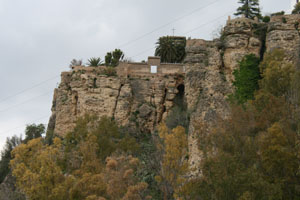 .Too dark to see the view - but the city of Ronda was built on top of a cliff, really - some of the older buildings blend perfectly from the stone and adobe to the natural cliff material - it's really incredible. There are still remnants from the Roman times, as well as Moors and later Castilians. I have lots of pictures, but none do the city justice. It is a spectacular old city full of history and beauty.
.Too dark to see the view - but the city of Ronda was built on top of a cliff, really - some of the older buildings blend perfectly from the stone and adobe to the natural cliff material - it's really incredible. There are still remnants from the Roman times, as well as Moors and later Castilians. I have lots of pictures, but none do the city justice. It is a spectacular old city full of history and beauty.  And today was another amazing day - I have lots of photos - again! - it was cold this morning and I hunkered in the van working on photos and stuff for much of the morning. The afternoon was very pleasant tho- I rode the trail with Soto and a camera crew in the Rhino - through wheat fields, and olive groves, and finally climbing up and over the hills into the valley of Antequera - the site of the Cathedral Saint Augustin, built in the 1500's, it was actually a monastery. A wonderful lunch (more food tonight) with local dishes, plenty of vino...
And today was another amazing day - I have lots of photos - again! - it was cold this morning and I hunkered in the van working on photos and stuff for much of the morning. The afternoon was very pleasant tho- I rode the trail with Soto and a camera crew in the Rhino - through wheat fields, and olive groves, and finally climbing up and over the hills into the valley of Antequera - the site of the Cathedral Saint Augustin, built in the 1500's, it was actually a monastery. A wonderful lunch (more food tonight) with local dishes, plenty of vino...  It's almost 10:30pm, just got back from the ride briefing and awards ceremony - it was held in an old bodega, La Gritana, where they have been making Manzanilla - Sherry - for a century at least. Huge old 'cave' in the middle of the city of Sanlucar Barrameda - the city at the mouth of the Guadalquivir River where it empties into the Atlantic.
It's almost 10:30pm, just got back from the ride briefing and awards ceremony - it was held in an old bodega, La Gritana, where they have been making Manzanilla - Sherry - for a century at least. Huge old 'cave' in the middle of the city of Sanlucar Barrameda - the city at the mouth of the Guadalquivir River where it empties into the Atlantic.  We entered the Donana Preserve again (one of the largest National Forest preserves in Europe) and started picking up the sandy trails and roads. The forest was in various stages - tall trees, medium, small - different stages of management. I asked Antonio about the shape of the trees - they only have the high limbs, the trunks are tall and curving and very elegant. Antonio told me that they keep the trees limbed like this because the summers get very hot, and wild fires are not uncommon - and the trees don't burn because the combustible needles are so high off the ground. Makes sense. beautiful too.
We entered the Donana Preserve again (one of the largest National Forest preserves in Europe) and started picking up the sandy trails and roads. The forest was in various stages - tall trees, medium, small - different stages of management. I asked Antonio about the shape of the trees - they only have the high limbs, the trunks are tall and curving and very elegant. Antonio told me that they keep the trees limbed like this because the summers get very hot, and wild fires are not uncommon - and the trees don't burn because the combustible needles are so high off the ground. Makes sense. beautiful too.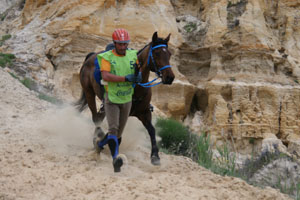 The afternoon was mile after mile of incredible beach. They started the ride so early this morning so that it would be low tide for the riders - long stretches of firm sand along the waves. After the vetcheck which was held on the beach below a village, we entered the preserve again. Pristine (for Europe) beach, dunes, controlled access. Soto obtained special permission to bring the ride through here, along with the support vehicles. The only other souls we saw were fishermen. It stayed gray and stormy all afternoon - a spit of rain for a few minutes, but that was the worst of it. By the time we got to the finish outside of Sanlucar de Barrameda the sun was starting to break though in spots.
The afternoon was mile after mile of incredible beach. They started the ride so early this morning so that it would be low tide for the riders - long stretches of firm sand along the waves. After the vetcheck which was held on the beach below a village, we entered the preserve again. Pristine (for Europe) beach, dunes, controlled access. Soto obtained special permission to bring the ride through here, along with the support vehicles. The only other souls we saw were fishermen. It stayed gray and stormy all afternoon - a spit of rain for a few minutes, but that was the worst of it. By the time we got to the finish outside of Sanlucar de Barrameda the sun was starting to break though in spots. 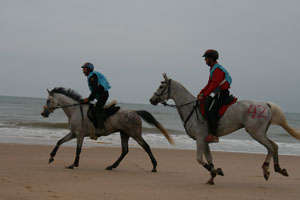 The horses and support rigs had to be ferried across the bay - the mouth of the Guadalquivir River - deep channels for commercial ships, strong wind, the ferry was swept sideways as it crossed the open water. For a few hours it made trip after trip across the bay with horses and rigs. It was an amazing - and tiring - afternoon - cool, windy - stopping all along the way for photos. The camera crew was a riot! they really worked hard and I'm not sure how they'll ever sort through all the incredible footage of horses galloping along the beach, crossing the dunes, chasing up huge flocks of gulls, splashing through the shallow waves.
The horses and support rigs had to be ferried across the bay - the mouth of the Guadalquivir River - deep channels for commercial ships, strong wind, the ferry was swept sideways as it crossed the open water. For a few hours it made trip after trip across the bay with horses and rigs. It was an amazing - and tiring - afternoon - cool, windy - stopping all along the way for photos. The camera crew was a riot! they really worked hard and I'm not sure how they'll ever sort through all the incredible footage of horses galloping along the beach, crossing the dunes, chasing up huge flocks of gulls, splashing through the shallow waves.